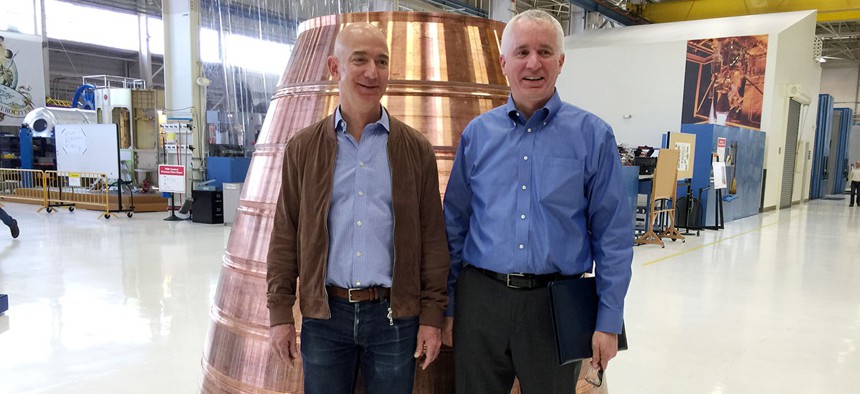Space Tourism Companies Are Going to Write Their Own Safety Rules Because the US Government Can’t

Blue Origin founder Jeff Bezos, left, stands with president Rob Meyerson in front of a copper exhaust nozzle to be used on a space ship engine on the company's research and production floor. Donna Blankinship/AP
The inaugural flights of these new ventures will be a leap into the unknown for the passengers.
Within a year, says Blue Origin, it will begin flying humans to the edge of space. That would grant the company, founded by Amazon chief Jeff Bezos, a symbolic victory over competitors like SpaceX, Boeing and Virgin Galactic, who are also pursuing plans to fly paying passengers beyond earth’s atmosphere.
The inaugural flights of these new ventures will be a leap into the unknown for the passengers, not least because they won’t benefit from the tight regulation we’ve come to expect in everything from air transport to private automobiles. The first spaceflight participants will be guinea pigs in an experiment that asks: Just what does it mean to be safe in space when the government isn’t in charge?
Risk incentives
Entrepreneurs often argue for a light regulatory hand to avoid stifling the development of new technology, and space entrepreneurs are no different.
“As we move to human space flight, there is no certifying body,” Blue Origin executive Erika Wagner recently told an audience at the Massachusetts Institute of Technology.
“The FAA [Federal Aviation Administration] is required to keep the public safe on the ground, but it’s not their responsibility to keep astronauts safe in space,” she continued. “That really is on our shoulders, and in terms of us having a safe place in the market, we take that seriously, we want to put our own families on board, we take that very seriously. So we are holding ourselves to internal standards.”
Her comment betrays an unusual reality. Technically, FAA does have jurisdiction over any space launches by U.S. citizens and companies. But when it comes to human spaceflight, the law is designed to give companies as wide a latitude as possible to develop their technology.
The Commercial Space Act allows the government to make safety rules for paying space passengers only if it is acting to prohibit a design or practice that has already “resulted in a serious or fatal injury” or “posed a high risk of causing a serious or fatal injury” in a previous flight.
Put more simply: Beyond ensuring that rockets won’t go totally awry, FAA doesn’t tell space companies how to protect their passengers until they’ve already put them in danger. In the meantime, space tourists must opt in after receiving a written warning of the risks they face, expressly acknowledging that the U.S. government has not certified their rocket as safe.
NASA’s powers of oversight are limited, too. Private companies that want to ferry people to the International Space Station, which NASA partly controls, will have to meet the space agency’s rigorous safety requirements. But for other kinds of space tourism, the business is supervised by FAA’s looser, almost self-regulatory, guidelines.
Who’s first?
Blue Origin’s flagship rocket, the New Shepard (named for the first American in space), flew for the first time in 2015. Then the company demonstrated the capability for a reliable and cheap human space tourism program by flying and reusing a second New Shepard rocket five times.
Blue Origin executives say it will begin regularly flying paying customers to space by March 2018. That would put them ahead of a planned test flights for NASA’s commercial crew program, which has hired Elon Musk’s SpaceX and aerospace giant Boeing to design vehicles and fly astronauts to the ISS. Both companies are going through a qualification process to demonstrate they meet NASA’s standards ahead of 2018 test flights, intended for May by SpaceX and August for Boeing.
Flying to the edge of space and flying to the space station are in fact quite different: Blue Origin’s rocket travels just 100 km (62 miles) up, while SpaceX and Boeing’s larger rockets are designed to carry heavy loads up 200 km or more. But that won’t diminish the rivalry between Bezos and SpaceX founder Elon Musk.
When New Shepard landed a reusable rocket booster about a month before SpaceX’s Falcon 9 did, it sparked a memorably catty tweet exchange between the billionaires, even though Falcon 9 had actually gone into orbit while New Shepard had merely grazed it.
SpaceX has also said it will fly two unknown passengers around the moon in 2018, after its first NASA flight. And Richard Branson’s Virgin Galactic, once the leading company promising space tourism, with a manifest of more than 700 paid passengers accrued since 2005, is still unlikely to begin operations before 2019. However, regular flight testing has resumed since a 2015 accident that resulted in the death of a test pilot.
What’s safe space travel?
That tragic failure underscored the risks of human space travel. Though Virgin Galactic uses a unique spaceplane with adjustable wings to carry its passengers, every space company has to solve the problem of keeping people safe in vehicles that can unleash the massive force needed to break the bonds of gravity.
NASA’s traditional approach to this challenge was to design, design and design again, spending enormous amounts of money to ensure nothing would go wrong. Tragic accidents did occur, but by and large “spending down risk,” as aerospace engineers put it, worked—as long as you had the government’s billions. This strategy was out of reach of most private companies until plunging costs of computation began to change the equation.
SpaceX was one of the first companies to find a balance between private risk-taking and NASA’s concerns. It developed its rocket to fly cargo to the ISS by relying on more testing to develop effective technology on the cheap. The situation was not without culture clashes—Musk told one agency official, only half in jest, he’d charge double for every NASA person at his work sites—but it produced a new orbital rocket that was a lot cheaper to run than its competitors.
NASA’s standards for carrying humans are even more rigorous, and government auditors have urged NASA to make contingency plans in case neither SpaceX nor Boeing meet them in time for their scheduled test flights.
Write your own rules
Blue Origin, though it looks to NASA for best practices, paints itself as a self-regulatory organization. SpaceX will have the same luxury should it fly private space tourists. Doing so means meeting FAA standards, which give a freer hand to the companies than NASA. In Silicon Valley parlance: Because Blue Origin is flying private clients first, it has a chance to scale up a “minimum viable product.” SpaceX, as a NASA partner, is working on an enterprise scale.
Any rocket carrying people will need a launch license from FAA, a spokesperson told Quartz. Getting the license is essentially a back-and-forth between the agency and the launch operator, with the company explaining how it will prevent problems arising from the moment the rocket begins preparing for flight until the mission is over. FAA evaluates data about the rocket’s performance and any new updates to its systems, and generally works to ensure the launch won’t end in flames.
Obviously, that offers some general safety for passengers. Going further is harder. As the agency’s lawyers put it in a rulemaking document, “Several commenters urged that the FAA establish requirements to protect space flight participants…[the Commercial Space Act] does not provide the authority to protect space flight participants except in certain circumstances,” when serious injury has previously occurred.
But FAA has found something of a backdoor method to extend its regulatory reach. If crew or passengers could be construed to do something that might cause harm to the public—or act to prevent it—FAA can make a rule about it. It requires, for instance, crew members and remote operators have pilot’s licenses, and that life-support systems be reliable enough “to ensure the crew’s ability to protect public safety” in the event of an accident.
Today, Virgin Galactic is the only space company with an FAA license to test its space plane. The license requires the company to “successfully verify the integrated performance” of its vehicle hardware and software by providing flight test results to FAA before any paying passenger is allowed on board.
Space Race Inc.
Because the slate is still blank for how the federal government will treat the space business, the earliest companies will be in a position to set the tone, much as Uber’s regulatory battles laid the groundwork for the still tetchy relationship between cities and ride-hailing apps.
Blue Origin still may not beat the pack to space tourism. In 2016, Wagner predicted the first human test flights would occur in the second quarter of this year, but it’s not clear if the secretive company in a business legendary for delays will meet that goal. Asked how many test flights would have to occur this year to prepare for human flight, she said, “we’ll see what it takes.”
Flying humans repeatedly and reliably would make Blue Origin the first true space tourism operation. It would mean heartburn for Virgin Galactic, which is putting more emphasis on a small-satellite launching business led by former Boeing and SpaceX executives.
For Bezos to truly trouble Musk and SpaceX, he will need get his first orbital rocket, New Glenn, built and flying by 2020. That will finally give him a vehicle with the power to match SpaceX to orbit and beyond.
This month, Blue Origin announced it already has a first customer for the rocket: Eutelsat, a European satellite operator. Lifting heavy commercial satellites to orbit is a key money-maker for SpaceX and its plans for inter-planetary exploration. If Bezos can dig into that market—and taking over new markets is, after all, his expertise—the new space race will truly be off and running.
NEXT STORY: The Jumbo Jet NASA Turned Into a Telescope



